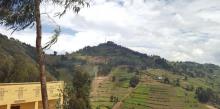Rwanda launches first African Air Quality and Climate Laboratory equipped to measure more than 50 gases that degrade the ozone layer and affect climate change. In a joint effort--between the Ministries of Education, Environment and Rwanda Meteorological Agency in partnership with the Massachusetts Institute of Technology (MIT) and hosted by the University of Rwanda, College of Science and Technology--Ron Prinn, EAPS TEPCO Professor of Atmospheric Science, and EAPS former PhD student Jimmy Gasore helped to initiate the Rwanda-MIT Climate Change Observatory Project with the Advanced Global Atmospheric Gases Experiment (AGAGE).

Kigali, Monday- January 15, 2019: The Minister of Education Dr. Eugene Mutimura officiated the ceremony to launch the first African Air Quality and Climate Laboratory equipped with the “Medusa system” that will measure more than 50 gases that lessen the ozone layer.
The $2 million project is being implemented by the ministries of Education, Environment and Rwanda Meteorological Agency in partnership with the Massachusetts Institute of Technology (MIT) and hosted by the University of Rwanda, College of Science and Technology.
Speaking at the event Dr. Eugene Mutimura, the Minister for Education noted that the MEDUSA system has equipment installed on top of Mugogo Mountain in Nyabihu District, to measure Hydrofluorocarbons (HFCs) that reduce the ozone layer. The equipment on the mountains will observe climate change in Africa, sense the sources and the amount of the gases being emitted in regional countries and inside Rwanda.
“This climate observatory project that set up the centre of excellence in Africa with air quality and climate lab will be informing policy makers on how to mitigate and adapt to climate change. Policy makers will be able to come up with measures to control car emissions, curbing deforestation and encouraging more tree planting, reducing use of fossil fuels, developing smart green cities and transport among many others,” The Minister said.
He added that a group of Rwandan technicians who studied atmospheric sciences from MIT are implementing the project. Dr Jimmy Gasore, an atmospheric scientist and chief scientist of the climate observatory project said that with climate observation, the government can predict weather events for adaptation and mitigation measures.
“We are a team of technicians working on measuring if these global warming gases such as carbon dioxide and Hydrofluorocarbons are being reduced or not,” he said
Gasore added that the climate lab will also coordinate eight other air quality testing equipment across all provinces that monitor and show sources of air pollution in various parts of the country. He noted that the data from the system will also enable Rwandan experts during different negotiations on climate agreements.
The Minister of Education extended his thanks to Massachusetts Institute of Technology (MIT) through Professor Ron Prinn, for choosing Rwanda to be the location of the 13th Global Climate Observatory in their Advanced Global Atmospheric Gases Experiment (AGAGE) network which has been measuring the composition of the global atmosphere continuously since 1978.
The Minister of Education recalled that the Government of Rwanda demonstrates the significant importance that we place on Science, Technology and Innovation (STI) for the development of our nation and the region and across Africa. He therefore greatly welcomed the partnership with MIT to establish the Global Climate Observatory in Rwanda which targets to develop high level skills in Atmospheric and Climate Science.
Read the full story on Republic of Rwanda Ministry of Education.
Story Image: Mt. Mugogo in Rwanda where the continent's first high frequency atmospheric station is located. (Photo: Gunver Vestergaard)
Link to article:



